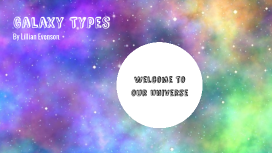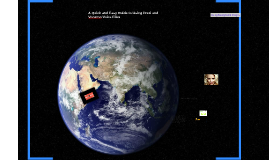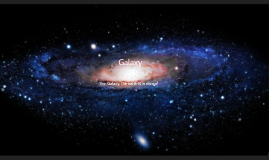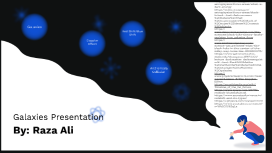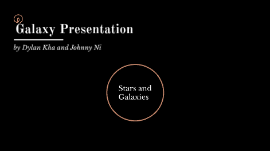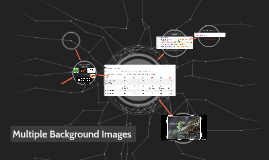galaxy presentation
Transcript: Galaxy Presentation by Dylan Kha and Johnny Ni Milky Way Stars and Galaxies Solar System Stars and Galaxies Galaxies Galaxies A galaxy is a cluster of millions and billions of stars, dust, and gas all held together by gravity. There is possibly a black hole is in the center of a galaxy. Irregular Galaxies An irregular galaxy is a galaxy that does not have a distinct regular shape, unlike a spiral or an elliptical galaxy. They are among the smallest galaxies and are full of gas and dust. Having a lot of gas and dust means that these galaxies have a lot of star formation going on within them. This can make them very bright. The Large and Small Magellanic Clouds are examples of irregular galaxies. They are two small galaxies which orbit around our own Milky Way Galaxy. About 20% of all galaxies are irregulars. Spiral Galaxies A spiral galaxy is flat with a bulge in the middle which is usually a black hole. It is called a spiral galaxy because of its arms that rotate around the center black hole. Our galaxy is the Milky Way, which is a spiral galaxy, which includes millions of stars even bigger than our sun. Elliptical Galaxies Galaxies come in many shapes and sizes. Among the largest are the “elliptical galaxies”, massive ball-shaped galaxies made up of trillions stars. The densest regions of the universe provide perfect conditions for growing elliptical galaxies. In rich clusters, galactic collisions are common. The largest galaxies pull in many smaller ones and build themselves by cannibalizing their neighbors. In dense galactic clusters, like the Coma Cluster located nearly 300 million light-years from Earth, the majority of galaxies are elliptical galaxies. In this cluster, they have all congregated towards the cluster’s center leaving the remaining spiral galaxies out towards the edges. Facts about galaxies Elliptical galaxies contain some of the oldest stars because they do not have the ability to form new stars. Elliptical galaxies are so bright that if Earth were located inside of one, there would always be day light everywhere no matter the time of day. A lot of irregular galaxies probably began as an elliptical or spiral galaxy that crashed into another galaxy. From the southern hemisphere of Earth, two other galaxies can be seen with the naked eye. A small galaxy is one that contains less than a billion stars. Stars Solar System Stars are is a large ball of burning gas in space. Stars appear to us as small points of light in the sky on clear nights. The central core of a star is extremely hot and produces energy by fusion, the fusing of elements usually hydrogen in this case. Some of this energy is released as visible light, which makes the star glow. Our sun, the center of our solar system, is a yellow star of average temperature and size. Facts about stars Stars that are blue are typically much hotter than the average star. At the most conservative estimate, there are at least 10 billion trillion stars in the universe. Stars are formed from dense knots contained in large clouds of dust and gas called nebulae. One in four Americans believe that the sun orbits the Earth, rather than the other way around. Every day, approximately 275 million new stars are formed in the universe. Thank you for watching!






